Next scouting mission for my Mercury News “Hikes” column: Portola Redwoods State Park.
Portola’s another of those “second-growth” redwood forests that sprang up after the previous redwood forest got clear-cut. The park map shows the Old Tree Trail about a half-mile from the park HQ, and, sure enough, the trail terminates next to a 280-foot, 1,200-year-old redwood — a rare survivor of the kill-em-all-and-let-God-sort-it-out ethos of California’s pioneer era.
In nearby Big Basin State Park the majestic giants are so common as to seem almost commonplace, but the giants have had a rough go of it at Portola. Another of the ancients along a nature trail near the HQ fell because of a camper’s fire in the late 1980s. One thing you learn about walking through forests — trees fall over and die all the time; they don’t need our help. But they do get it.
There is one impressive stand of old-growth redwoods at Portola but you’ve gotta hike 13 miles out and back to see it. Having already done that hike last year (write-up here), I tried some other trails on Saturday. On Sunday I went back with 4WheelBob — we had so much fun, I’m gonna devote a separate post to it.
For hardcore hikers, one of the coolest things about Portola is its proximity to more trails nearby — at Long Ridge Open Space Preserve to the northeast and Pescadero Creek County Park to the west: from here the truly intrepid trekkers can find their way to Butano or Big Basin Redwoods state parks (perhaps both if you’re truly crazy).
I was more into the sane hiking on Saturday, so I started out on the Iverson Trail, the most common trail name on the paths around the park HQ. Named after an early settler, Iverson Trail threads through the woods with mild ups and downs, crosses the Pescadero Creek, which runs all year, and connects to the Coyote Ridge and the Pomponio trails, both of which find their way to Pescadero Creek County Park nearby. To keep things simple, I stayed within the park’s boundaries.
In the winter, a must-see spur from Iverson is to Tiptoe Falls, which tumbles down a tributary into the Pescadero Creek. It’s barely a trickle at this time of year, but that didn’t stop me from trying to snap off a few frames. I figure if I keep this up I might actually know what I’m doing when waterfall season returns.
Not much to see here, I admit. I did fiddle with the shutter speed to get a bit of a blurring effect.
A few leaves growing across the trail. Yes, this is an attempt to be somewhat artsy.
There’s a good-sized amphitheater near the park’s main campground, and nearby there’s this concrete pyramid with this occult-symbol-looking fresco. The Shriners used to own this land and donated it to the state after World War II; I’m guessing this thing is their doing.
After bopping around on the Iverson Trail I headed up the Coyote Ridge Trail for about a mile. This whole area looks vaguely distressed; lots of fallen trees and gaps in the forest.
Here’s one bit of wreckage.
Here’s another. Imagine the crack it must’ve made. Probably heard it in Palo Alto. No, come to think of it, that can’t be true because if it were, the citizens of Palo Alto would’ve demanded an ordinance banning loud noises emanating from the nearby hills, and I’m sure we’d have put such a story in the paper.
After a mile or so you can take the Upper Coyote Ridge Trail or head back downhill — I chose the latter, and made my way over to the Slate Creek Trail, which heads over to the park’s backpacker’s camp. A spur also heads over to the Old Tree. Along the way over here, I stuck my camera up into a burned-out section of redwood and turned it skyward. This picture is the result.
Here’s the Old Tree. Pictures can’t do these behemoths justice and I’ve pretty much given up on trying.
Hikers of all ages on the Old Tree Trail. If you come to Portola with only an hour or so to spare, spend it on this trail. It’s a mild uphill, a wide trail, and has a bunch of interpretive plaques explaining the redwood forest ecosystem.
The Slate Creek Trail is the most pleasant path at Portola — uphill for a couple miles but at a very easy grade. The forest is rich, cool and comforting here, a nice contrast from the more rugged — and ragged — areas along some of the other trails.
As much as I like the trees at Big Basin, I like the story of Portola, the same one being told all up and down the coast as “second” growth regenerates damaged forests. “Second” belongs in quotes because we’re the ones doing the counting. I mean, really, how many forests have occupied this land since forests started appearing over 300 million years ago? (There used to be an ocean here, though with continental drift it hasn’t been precisely “here” all that long, in geologic time).
With our state parks and preserves we imagine we’re giving all these forests a second chance at life, when it’s exactly the other way around: these forests are giving us the second chance. Here’s hoping we make the best of it.
More Portola links:

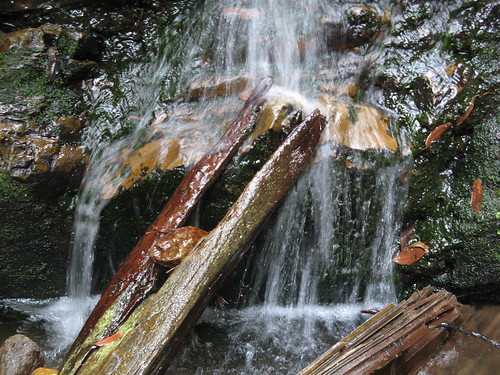
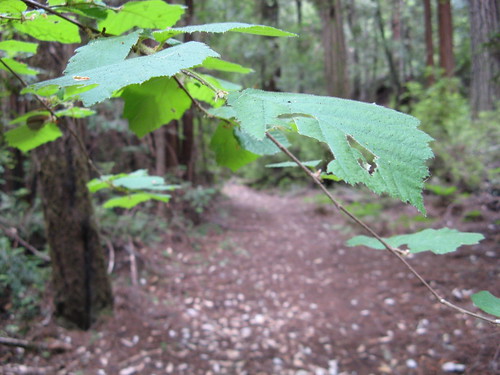
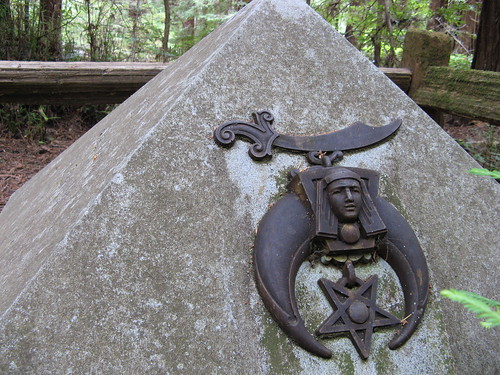

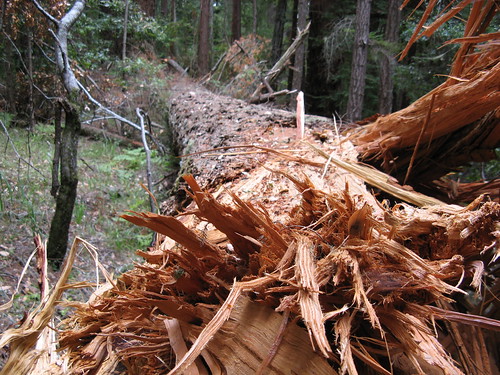
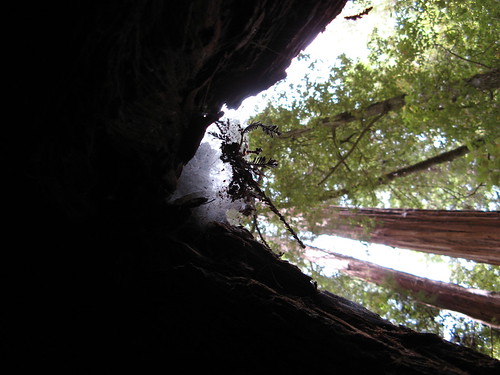

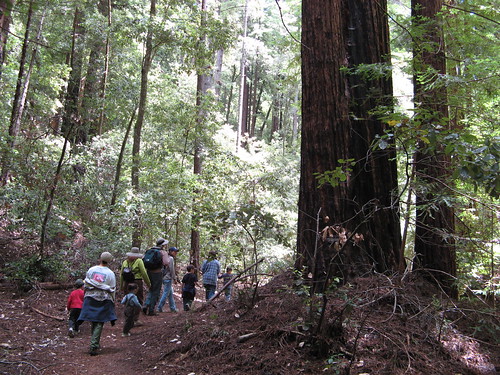
Nice shots, Tom! Imagine, Gambolin’ Man’s not been to Portola since 1984! I must return . . but I’ll wait until the rainier season for big water!
At the risk of making a pest of myself, I have to say, great hike report Tom and I especially liked your ending about the forests giving us a second chance. I happend to watch Bill Moyer’s Journal Friday night and he interviewed the famed biologist, E. O. Wilson (http://www.metrokc.gov/dnrp/swd/naturalconnections/edward_wilson_bio.htm).
In the interview, Professor Wilson made a comment about the value of the diversity of life on this planet and its dollar worth to humanity. If you added up the services that trees and wetlands, and insects, and yes, even the little fishes provide us (you know, like the little smelt getting creamed in the pumps over in the delta that a lot of people could care less about), the services performed add up into the trillions and trillions of dollars in value from the air and water purified to pollination of crops and though ways I can’t even imagine.
I want to see our wildlife and habitat preserved just because I love it and it renews my spirit to go out into it and to feel one with it. I feel richer for it. For those who would destroy it for profit or because saving it is inconvenient, in the end, that destruction will be a far greater inconvenience than we can imagine and profit will be the last of our worries.